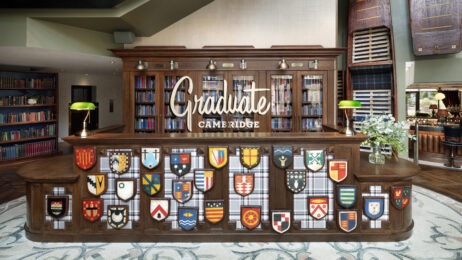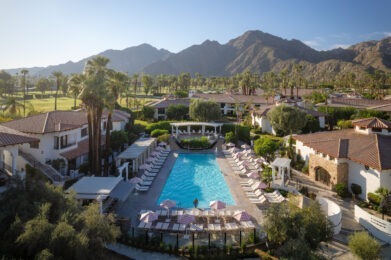Detroit rolls up its sleeves to forge a bright future
At the height of the economic crisis in Detroit, the city’s outlook had never seemed so bleak. Detroit had suffered decades of population decline, urban blight, political corruption and high crime rates that left the former capital of the auto industry in shambles. The city hit rock bottom, filing for bankruptcy in 2013, as the rest of the world wondered how things had gone so wrong.
But everyone loves a comeback story, and today, Motor City is back on its feet and moving forward at a rapid pace. Investors have raised more than $11 billion toward Detroit’s resurrection, which has put the city back on the meetings map in a major way—according to Detroit Metro Convention & Visitors Bureau, convention bookings are up by a whopping 128 percent.
During the annual American Society of Association Executives (ASAE) meeting and exposition held last year at Cobo Center, Josh Linkner, a venture capitalist and Detroit native, gave the opening speech. He praised the city’s radical transformation and great potential for businesses to flourish from the ground up.
Linkner founded investment firm Detroit Venture Partners, and is one of many entrepreneurs to have infused Detroit with a burst of tech innovation. In addition, young talent and new projects have made this up-and-coming destination ready to reclaim its throne as one of America’s great cities.
Renaissance City
Detroit Metro Convention & Visitors Bureau was instrumental in turning the city’s image around through strategic advertising and key messaging. The organization actively works to promote Detroit, through its latest campaign, as a place of courage and true grit, where great ideas thrive and success stories abound.
“Our staff consistently works…to help change perceptions and spread the positive stories taking place in the city,” says Bill Bohde, senior vice president of sales and marketing at Detroit Metro Convention & Visitors Bureau. “[Our] campaign emphasizes the pace of the new development and the transformation taking place, which is now resonating around the world.”
Downtown Detroit has undergone a renaissance of sorts with The Detroit International Riverfront at its core. The greenway encompasses a marina, parks, restaurants, retail stores and skyscrapers. Million-dollar investments are supporting riverfront development, which includes a number of hotels facing the Detroit River.
Cobo Center also lines the waterway and recently wrapped up the final phase of a $279 million expansion, bringing its total footprint to 2.4 million sq. ft. New additions to the convention center include a 40,000-square-foot ballroom, 50,000-square-foot exterior plaza and stunning 30,000-square-foot glass-enclosed atrium with floor-to-ceiling views of Windsor, Ontario, across the river. The building also features a TV broadcast studio with satellite capabilities and exterior high-tech video walls located above the entrance.
Indie Spirit
Next door, Midtown is one of the fastest-growing neighborhoods in Detroit. Groups can experience the cultural heart of the city in Midtown’s many live music venues and theaters, world-class museums, such as Detroit Institute of Arts, and boutique shops and galleries. The neighborhood has helped fuel the city’s growing culinary and brew pub scene. Local microbreweries, such as HopCat, provide intimate event spaces for up to 400.
“For smaller meetings, Detroit has dozens of unique meeting spaces available, from historic to recently rehabbed buildings, each with its own distinct charm,” Bohde adds.
Corktown is slightly off the beaten path, but well worth a visit for its historic charm and beautifully restored Victorian row houses. Detroit’s Irish population founded the neighborhood in the 1830s. It later received designation on the National Register of Historic Places in 1978.
Although residential in nature, more eateries, local bookstores and quaint cafes are cropping up on Corktown’s streets. Visitors can glimpse some of the earliest dwellings in Detroit’s oldest neighborhood during this year’s annual Corktown Historic Home and Garden Tour, which takes place in June.
Ultimate Fan Experience
The section between Downtown and Midtown was previously underutilized, but that’s all about to change with several multiuse entertainment venues under construction near Woodward Avenue. Plans for The District Detroit include six theaters and three sports arenas that will be home to the NHL Detroit Red Wings, MLB Detroit Tigers and NFL Detroit Lions, making it the ultimate sports experience.
The $627 million Detroit Events Center is one of the most anticipated venues to arrive at the new district. The hockey arena will feature dramatic bowl seating with great sight lines of all the action. When it’s not crowded with Red Wings fans, the center will serve as a concert venue with state-of-the-art technology and fan amenities.
By summer 2017, The District Detroit will connect the two neighborhoods with additional residential, office and retail developments that create a vibrant urban setting for locals and visitors to enjoy. Construction of the area is expected to generate at least $2.1 billion in total economic impacts.
“There is so much for meeting attendees to see and do while in Detroit for their conferences,” Bohde says. “While here, they will get to experience the comeback, see all the major changes taking place, and be an integral part of the comeback.”
Improvements in Transit
To keep on pace with the rest of the city’s improvements, an upgrade to public transportation will come via the M-1 Rail. As new buildings and city attractions emerge along Woodward Corridor, the new streetcar will be critical in connecting Midtown and Downtown Detroit. Construction is well underway and will be up and running by late 2016, just before The District is officially complete.
“The M-1 Rail will fill a vital need to help connect Downtown to Midtown, making it easier and more affordable for meeting attendees to get around Detroit,” Bohde says.
The 3.3-mile rail will traverse both sides of Woodward Avenue, servicing 20 stations in 12 locations. Original plans to expand metro transportation called for a 10-mile fixed rail car, but it was ultimately determined that a smaller system would better complement existing bus service and the Detroit People Mover. The M-1 Rail will spur economic development and provide a foundation for improved and expanded public transit throughout the region.
Explore
Granite City Food & Brewery

A new brewery has arrived at Renaissance Center complex. Granite City Food & Brewery opened in February with private dining rooms, and an outdoor patio joins the restaurant this spring. Groups can sample signature pale ales, IPAs and lagers.
Henry Ford Museum

Visit the largest indoor-outdoor museum complex in America, which pays tribute to Henry Ford, founder of Ford Motor Company. His namesake museum provides a historical timeline of the Industrial Revolution and American transportation.
Polk Penguin Conservation Center at Detroit Zoo

Detroit Zoo will soon have the world’s largest penguin facility when Polk Penguin Conservation Center opens April 18. The 33,000-square-foot center will hold more than 80 penguins from four species: Gentoo, Macaroni, Rockhopper and King.
Must See
Belle Isle Park

In the middle of the Detroit River lies an island oasis with several unique attractions. Belle Isle Park has its own aquarium, conservatory, zoo, municipal golf course, historic monuments and a half-mile swimming beach.
Belle Island Aquarium is an iconic landmark that offers free admission to view several species of fresh and salt-water fish. Belle Island Nature Zoo also offers free admission for visitors to experience animal encounters, with deer feedings and bird ovservation windows.
Anna Scripps Whitcomb Conservatory and Dossin Great Lakes Museum also provide free admission and nature-inspired settings for group offsites.
Major Meeting Venues
Detroit
Atheneum Suite Hotel
Newly renovated Greek-themed hotel; 174 guest rooms; 26,000 sq. ft. of meeting space.
Crowne Plaza Detroit Downtown Riverfront
Adjacent to Cobo Center; 367 guest rooms; 11,000 sq. ft. of meeting space.
Detroit Marriott at the Renaissance Center

Newly renovated 70-story building on the RiverWalk; 1,298 guest rooms; 100,000 sq. ft. of flexible meeting space; 34 meeting rooms.
Greektown Casino-Hotel
30-story hotel with casino; 400 guest rooms; 20,000 sq. ft. of meeting space; 11 breakout rooms; 4,000-square-foot-ballroom; live entertainment; spa.
MGM Grand Detroit
Forbes Four Star, AAA Four Diamond gaming property; 400 guest rooms; 30,000 sq. ft. of meeting space; entertainment and dining options.
MotorCity Casino Hotel
Gaming property; 400 guest rooms; 67,000 sq. ft. of meeting space; Sound Board theater seats 2,400; AAA Four Diamond restaurant; spa.
Renaissance Conference Center
20,000 sq. ft. of meeting space in six rooms; connected to Detroit Marriott at the Renaissance Center and Courtyard by Marriott Detroit Downtown.
The Henry, Autograph Collection
Luxurious property in nearby Dearborn; 308 guest rooms; 38,823 sq. ft. of meeting space; gallery-style art collection.
The Westin Book Cadillac Detroit

Italian Renaissance-style hotel built in 1924; named to National Register of Historic Places; 453 guest rooms; 30,000 sq. ft. of meeting space; Michael Symon’s Roast restaurant.
The Westin Detroit Metro Airport
Connected to Detroit Metro Airport (DTW); 404 guest rooms; 7,330-square-foot ballroom; 34 meeting rooms.
The Westin Southfield Detroit
20-minute drive from downtown; 388 guest rooms; more than 50,000 sq. ft. of meeting space; 25-plus meeting rooms; IACC-certified conference center.




